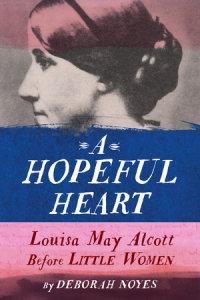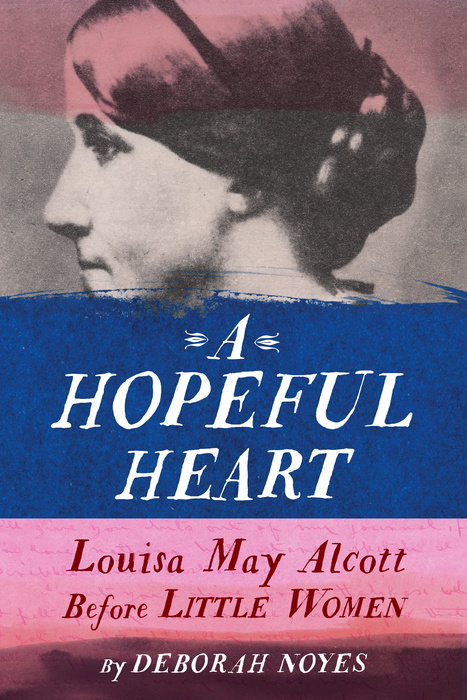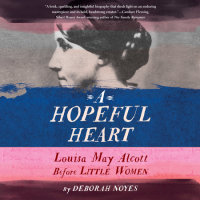A Hopeful Heart
How did Little Women-- the beloved literary classic and inspiration for Greta Gerwig's acclaimed feature film adaptation--come to be? This stunning biography explores the unique family and unusual circumstances of literary icon Louisa May Alcott.
Meg, Jo, Beth, and Amy. How did these cherished characters come to be? Louisa May Alcott, the author of one of the most famous "girl" books of all time, was anything but a well-mannered young lady. A tomboy as well as a ravenous reader, Louisa took comfort in fictional characters that were as passionate and willful as she was--and whose wild imaginations were a match for her own. She was often found roaming the woods near her home in Concord, Massachusetts, or exploring the natural world in the company of the great Transcendentalist thinkers Ralph Waldo Emerson and Henry David Thoreau. Here is a beautiful portrait of Louisa May Alcott, a woman influenced by her father, a penniless philosopher, her mother, with whom she shared a great connection, and, of course, her three sisters. Featuring unique indigo illustrations, Deborah Noyes unveils how Louisa's natural spirit, loving family, and unconventional circumstances inspired the timeless masterpiece that is Little Women.
An Excerpt fromA Hopeful Heart
1
The Forbidden_Apple Experiment
1832–1834
She has withstood the temptations of the appetites through a whole morning, and though they triumphed, at last, the triumph was not without a struggle.
--Amos Bronson Alcott, journal, 1833
Louisa May Alcott never liked her birthday. “On a dismal November day I found myself,” as she put it, and “began my long fight.”
Her mother remembered that day in 1832--and her daughter--differently. The infant Louisa was a “sprightly, merry little puss,” Abigail Alcott wrote, “quirking up her mouth and cooing at every sound.”
Louisa the fighter found herself in the heart of an unusual family.
Amos Bronson Alcott, Louisa’s father, was an educator and philosopher fascinated by human nature. Louisa’s mother shared his ideals and was fiercely committed to social change.
When Anna, the first of four Alcott daughters, was born on March 16, 1831--twenty months before Louisa--Bronson wrote grandly, “A child is given. May we guide it in the paths of truth.” He saw the new baby as an invitation to a great experiment: What is human happiness? Can it be built from the ground up? Can parents limit outside influences and raise a perfect child? How do children learn?
To find out, he took scrupulous notes on his firstborn’s mental and moral growth. He looked and listened, like any attentive father, but also exposed Anna to stimuli, like a scientist. What faces would she make? What sounds and gestures? His laboratory was built on gentleness and reason, but Bronson’s curiosity sometimes got the better of him. What would happen, for instance, if he made a scary face? (That experiment “must not be repeated,” he concluded. Fear, however mild, only subtracted from a child’s happiness.)
He called his journal “Observations of the Life of my First Child” and intended it to be no less than a “history of the human mind . . . faithfully narrated.”
Louisa arrived in the world on Bronson’s thirty-third birthday, and she too became part of the family experiment.
The sisters were in every way a study in contrasts, their father observed.
Bronson believed in the divine purity of young children: newborns came into the world still in touch with instincts and intuition from the spiritual realm. Mild, sentimental, and eager to please, Anna was fair and serene like her father. She fit his concept of the ideal infant.
Louisa, with her “vivid, energetic” power, individuality, and force, did not. An active, fretful baby, she challenged her father’s theories from the beginning (and would challenge him all her life).
Louisa was practical and proud, with a fierce will, imagination, and temper. She had storm-dark eyes--some said gray, others black--and her mother’s olive skin.
In a letter to his own mother, Bronson praised his wife’s maternal devotion. She “lives and moves and breathes” for her family, he wrote. But at the same time, he gave Abby full credit, or blame, for the baffling phenomenon that was Louisa.
Overworked and in poor health during the formative early months of her daughter’s life, even Abby looked back and blamed herself for Louisa’s moodiness.
Born with “the wild exuberance of a powerful nature,” Louisa was certainly “fit for the scuffle of things,” as Bronson put it, and their household was nothing if not a scuffle.
Clamoring for the attention of two intellectual, socially active parents, toddler Anna lashed out at her mother and sometimes struck her. Anna slapped and scratched Louisa the intruder one minute--though she always agonized afterward--and slathered Louisa in kisses the next.
Not to be outdone, tiny Louisa mastered the art of the tantrum, learning to howl and collapse into a heap on the floor, wedging her head between her knees and screaming bloody murder. Sobbing before bedtime became one of her “most confirmed habits.”
Trying to mold the perfect family in crowded chaotic conditions wore on Bronson. The family lived at the time in Germantown, Pennsylvania--about six miles outside Philadelphia--while he tested his radical educational methods at a suburban school funded by wealthy Quakers. His roles as father and educator were hard to separate, and with his suburban experiment on the wane and bills piling up, Bronson closed the Germantown school. He rented an apartment in the city of Philadelphia, leaving Abby to manage the girls and the household alone. Bronson disappeared into the hallowed halls of Philadelphia’s public library collections to study educational tracts and philosophy, and walked six miles each way on weekends to spend time in Germantown with the family.
On April 22, 1833, he opened a new school in the city with fifteen students, and while Abby and the girls occupied a series of boardinghouses in Germantown and then Philadelphia, Bronson kept his distance.
When he visited the family, he and Abby argued over responsibility. His absence kept her mind “in a state of excitement,” she confessed. He was “unkind, indifferent, and improvident,” and when he was present, he held “too closely to the ideal” of a family, leaving no room for error.
Bronson saw educational reform as both “duty and right” and argued that in order to make a difference in the world, he had to live and defend a serene life of the mind. “Sacrifices must be made to the spirit of the age,” he reasoned. “My family must feel the evil of this to some degree, but this should not deter me.”
Louisa and Anna continued to be subjects of their father’s intellectual inquiry. One of Bronson’s child-development experiments featured a shiny, forbidden apple.
He sat his daughters down one day and asked, “Should little girls take things that do not belong to them without asking their fathers or mothers--things to eat or drink--things they may like?”
“They should not,” asserted four-year-old Anna.
Did the girls think that if they should see an apple, they would ever take it without asking for it?
Anna shook her head. No. Never.
Louisa agreed.
Bronson then set an apple out where the girls would see it and quit the room. At dinnertime he returned to find a browning core on the table by Louisa. Once the family finished their meal, Bronson asked about the object near her plate. What was it?
“Apple,” Louisa said.
“Where did you get it?”
Her eyes darted to Anna, who could barely contain herself.
“I told her she must not,” blurted the obedient older sister, “but she did!” They had both taken a few bites before Anna had thrown the apple into the fireplace grate. But Louisa had seized it and finished it. “I was naughty,” Anna confessed. “I didn’t ask you, as I ought to--shall you punish me father, for it?”
Bronson had put the apple there on purpose to “try” them, he explained. “I rather thought you would take it; but I hoped you would think of what I had said and that you would not take it. Did you think you were doing right?”
“No,” said Anna, “my conscience told me I was not.”
“And shall you mind it next time?” he asked.
“Yes, I think I shall.”
“Well, Anna, always mind that, and then you will do right.”
Louisa toddled over, and he pulled her up onto his knee. Had she eaten some of the apple?
“Yes, I did.”
“Why did you take it before father said you might have it?”
She smiled ear to ear. “I wanted it.”
Louisa’s turn at playing Eve to her father’s Jehovah didn’t end there. Bronson conducted at least one other such test with her as subject, leaving an apple conveniently in sight while he hid nearby to watch.
Faced with the forbidden fruit, Louisa scolded herself: “No, no--father’s--me not take father’s apple--naughty!”
But her plump little hand reached out.
Louisa didn’t eat the apple at first. She played with it and nearly ate it--several times, her father recorded--but in the end, temptation won, and conscience lost. “Me must have it,” she told the air, biting into the apple’s crisp flesh.
Bronson didn’t punish Louisa. (He had seen his “spiritual principle” in action: his youngest had struggled with the question, and that was enough.) Though surely she felt the wages of her sin. For not the first time, Louisa had disappointed her father.
But she was not one to be daunted.
By the time she was eighteen months old, Louisa and her sister had already lived at four different addresses while their father was looking for a foothold as a teacher.
The new school struggled on for a year, though Bronson no longer saw Philadelphia as fertile ground for educational reform. The people there seemed to him material-minded, “not deeply interested in intellectual and moral subjects.” In the end, this project failed like the other. The parents of Bronson’s pupils continued to find his methods--such as asking children to keep diaries of their spiritual and intellectual progress--unconventional and unsettling, and pulled their children out.
Philadelphia might not be ready for an experimental classroom, Bronson supposed, but maybe Boston was.
The family had “continued at this place 2 years,” Abby wrote in her journal, “with uncertain and vacillating prospects of success.” They decided to return, without delay, to her home city. Over the years and decades to come, Abby would master the art and particulars of relocating her family, and once a decision was made, plans would develop quickly.
On the day of the move, Abby--“Marmee” to her girls--dressed Anna and Louisa in clean, crisp traveling frocks. The Alcotts and their belongings were not long aboard the Boston-bound steamboat when toddler Louisa wandered off, as she would throughout her childhood, in search of adventure.
A panicked search ensured, and the family found their naughty runaway, at last, belowdecks in the engine room. Louisa sat lost in play, oblivious to steam and danger and the ship’s clanking machinery, her white dress smeared with soot.
2
Queen of the Revel
1834–1835
My father taught in the wise way which unfolds what lies in the child’s nature, as a flower blooms, rather than crammed it, like a Strasbourg goose, with more than it could digest.
--from Louisa May Alcott: Her Life, Letters, and Journals
Bronson’s magnetic charm with children and his radical teaching methods fast became the talk of Boston, thanks in part to family friend Elizabeth Palmer Peabody, herself a brilliant educator.
A classical scholar gifted in mathematics and languages, among other subjects, Peabody was “amazed” by the student work Bronson sent from Pennsylvania, especially the caliber of the children’s writing.
His mission as an educator, Bronson told her, was to draw out, through guided conversation, ideas and truths already present in a child’s mind and spirit. By asking pointed questions, he encouraged pupils to discover and decide for themselves. He would gently lead them to define a position or reach the conclusion the teacher sought--but on their own. He also maintained that children were holy innocents, with something to teach adults.
This was news to Boston--news that Peabody spread with enthusiasm, drumming up early support among the city’s intellectual elite and its foremost citizens. Bronson Alcott seemed to Peabody a bright light with an unmatched “genius for education.”
When enough families had committed, Bronson rented space for his experimental school upstairs in the Masonic Temple on Boston’s Tremont Street. He invited Elizabeth Peabody to assist him--without pay at first--and she accepted. The school opened its doors on September 22, 1834, with twenty students, the majority from prominent families and under age ten. Nearly half of them were girls. (Parents may have been more willing to experiment with girls’ education; most girls in that era would not proceed to trades or higher learning.) The youngest pupil was a grandson of former president John Quincy Adams.
Sunlight poured through a high arched Gothic window into the spacious schoolroom. Plaster faces of Plato, Socrates, Shakespeare, and the Scottish writer Sir Walter Scott gazed down with blank eyes from pedestals in corners. Paintings lined the walls, and each tidy desk had its own private bookshelf.
Chock-full of objects to inspire thirsty minds--alarm clocks, decks of cards, a globe, an hourglass--Bronson’s schoolroom even kept a pitcher of water at the ready to quench thirsty bodies. He had thought of everything, it seemed.
When the tall, blue-eyed scholar walked in that first day, addressing students in his serene voice, “Every face was eager and interested,” Elizabeth Peabody reported. In her notes for that day, she wrote:
Mr. Alcott sat behind his table, and the children were placed in chairs, in a large arc around him; the chairs so far apart, that they could not easily touch each other. He then asked each one separately, what idea he or she had of the purpose of coming to school? To learn; was the first answer. To learn what? By pursuing this question, all the common exercises of school were brought up by the children themselves.
Bronson divided human personality into four major aspects: animal nature, affection, conscience, and intellect. A good teacher educated the whole child, including physical or “animal” needs--and so the day began with play.
After fun and games came conversation. Bronson’s method of Socratic dialogue--a system of rational questioning developed by the ancient Greek philosopher Socrates, which draws out a subject’s implicit knowledge--gave students the chance to share their own wisdom. They were also encouraged to sing and clap between lessons.
Bronson’s methods were highly unusual at a time when most teachers viewed children as wild hooligans in need of civilizing, when instruction amounted to memorization drills, and when misconduct earned stern punishment. Many schoolmasters of the day practiced corporal punishment--smacking a child’s bottom with a paddle or the knuckles with a ruler--on a routine basis to keep order in the classroom, and here again Bronson broke the mold. “The child has rights,” he wrote, “as well as the adult. The right of self-government, and the liberty to govern.” He refused to punish a student until the offender acknowledged that the punishment was just.
When two boys acted out one day in class, Bronson proposed that some children might find it worse to inflict pain than to receive it. He held out his own hand and ordered the offending boys to strike him.
A “profound and deep stillness” fell over the classroom, Elizabeth Peabody recorded. The boys took their punishment, striking their teacher’s hand with the ruler, but their eyes shone with tears.
Peabody came to live with the Alcotts in their boardinghouse lodgings on Chauncey Street in Boston, which was a relief for pregnant Abby. “She is very fond and sweet with children,” Abby wrote, “and often keeps mine for hours interested in stories and pictures to her own evident satisfaction.”
Abby also admired Peabody as a person and enjoyed her company. “She is truly good . . . very poor, but hopeful and resolute. She is not the first genius that has craved bread.”


